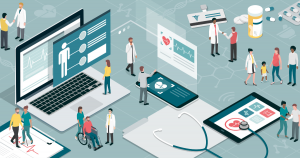“If you want to know where the investment is [in healthcare], follow the ‘Rs’.” This was a key message delivered at Dreamforce in 2015 by Salesforce Chief Medical Officer Joshua Newman, MD MSHS, during his keynote.
According to Newman, the first phase was all about revenue (revenue cycle management). The second phase, saw significant investments into records (electronic health records). And the third phase? That’s all about relationships.
“People are investing in relationships because it solves problems,” he said. While this message was over three years ago, it still holds true today.
The emphasis on relationships has created a heightened awareness around the patient experience. Providers, payers, and pharmaceutical and medical device companies are figuring out how to leverage the data they’ve been collecting to orchestrate an enhanced, more personalized experience for the patient and drive improved outcomes.
While this focus on the patient has been a long time coming and is critical to achieving the Triple Aim of healthcare, there’s one key part of the relationship equation that has been somewhat overlooked: the clinician. In fact, as greater demands have been put on clinicians across the spectrum of healthcare to document clinical and non-clinical data, many feel it’s increasingly taken them away from what they got into the profession to do –– engage with patients face to face. This, according to a recent article published in the American Journal of Medicine, has led to a lack of enthusiasm and accomplishment, and increased cynicism.
Clinicians are burdened and facing burnout
The number of articles, reports and studies about physician burnout in today’s healthcare environment abound. For instance, the same American Journal of Medicine article cited a study that revealed a near 10% increase in physician burnout –– from 45.5% to 54.4% between 2011 and 2014. A more recent study from 2018 showed slight improvements, with 42% of physicians reporting burnout, down from 51% the year prior.
What’s causing the burnout? Unfortunately, it’s not an easy answer. There are a number of forces coalescing to drive this trend. A blog post on HealthAffairs, authored by 11 healthcare executives, attributed the burnout to a “loss of control over work, increased performance measurement (quality, cost, patient experience), the increasing complexity of medical care, the implementation of electronic health records (EHRs), and profound inefficiencies in the practice environment, all of which have altered work flows and patient interactions.”
Similarly, the authors of the American Journal of Medicine article investigated several major transformational medical practice events including, rising drug prices, the Affordable Care Act, pay-for-performance, and mandated EHRs. Ultimately, they rooted out all but EHRs as a primary contributing factor to burnout. Other surveys have also pointed to mounting systematic pressures and administrative demands as the leading causes of clinician burden.
Physicians are losing face time with patients in an effort to keep pace with requirements to collect and manage data across disparate systems. At the same time, patient behavioral changes are significantly impacting the industry. Today, patients want greater transparency, access to their own data and their providers, and a more connected, seamless experience across their providers. Yet, many of the technologies in place to support these demands are taking clinicians away from the human connection, and thus the ability to be attentive to the more subtle cues they once relied on.
So, what’s the solution?
Connecting systems to match workflows
How do we begin to alleviate this burden, decrease the burnout rates and create a more connected experience for all involved in the healthcare equation? For starters, connected care requires connected systems. Disconnected systems and manual processes not only burden clinicians, they’re also costing organizations in numerous ways –– wasted resources, physician turnover, unnecessary technology spends, lost or misinterpreted data, etc.
Today, most caregivers use an EHR as their healthcare management system, but the problem ––and the reason many feel they’re dedicating too much face time to the computer screen –– is they also have to rely on a kluge of nonintegrated programs to provide a more comprehensive solution. This is where data has the potential to be lost or misinterpreted, and can also make processes unnecessarily cumbersome for caregivers.
The one-size-fits-all, general-purpose platforms are no longer cutting it. Processes in patient care are complex and regulatory issues are only adding to that complexity. Health management systems have to be purposefully built to match the workflows of the various clinicians who use them, and this often requires integration. With modern integration platforms, critical data can flow more quickly and securely.
For instance, when an EHR is complemented by an integrated CRM system, it can automate certain repetitive jobs such as patient communication and management, to free up caregivers to focus on what they got into the profession to do. A CRM can also provide a complete view of the patient by siphoning in data from multiple sources and making that data more accessible to all members of the patient’s care team.
Achieving transformation through design thinking
To create a purpose-built platform it requires design thinking to truly meet the needs of, and to do this, we have to gain a 360-degree view of the provider. What does their end-to-end experience look like? What is their workflow and requirements? Where are their friction points?
Applying design thinking means looking at the existing experience and examining how it could be helping or hindering them from doing their job. It’s mapping the journey through the user’s lens to create a streamlined and positive experience.
You might start with a more mature process that is detailed enough that you know you can augment. Go through the entire provider journey, pinpointing every touchpoint they have with the health management system, look for points of friction or where data has the potential to be lost in the exchange. Get their input as well. Ask where they feel they are spending most of their time on administrative tasks and what functions they find challenging to use.
If you’re using custom-coded or point-to-point integration tools, it’s worth taking a critical look at your current system as well. Is your current integration complicating the process? Can it easily scale to address future workflow needs or processes? How secure is the integration? Is it easy to audit and update to remain in compliance?
Making efforts to modernize and streamline clinician workflows through design thinking, and creating a purpose-built, integrated EHR can have a positive windfall effect on your organization. Not only will it help enhance the provider experience, it will support more efficient flow of data, which can dramatically improve the delivery of care –– and that’s the ultimate goal.








